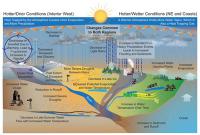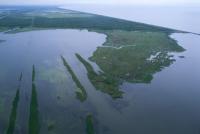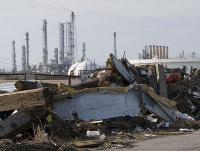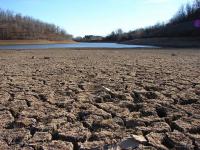-
Experts urge negotiators to include water in climate agreement

The impact of climate change is felt through water, with flooding, erratic rain patterns, prolonged droughts, and other extreme weather events. Water is also critical for successful climate change mitigation, as many efforts to reduce greenhouse gas emissions depend on reliable access to water resources. World Water Week closed on Friday in Stockholm, with the Stockholm International Water Institute (SIWI) urging climate negotiators to ensure that water is integrated in the global 2015 climate agreement.
-
-
Restoring and sustaining Louisiana’s eroding coast

Measures taken over the last ninety years to prevent a repetition of the 1927 New Orleans flood — the construction of improved levees, spillways, and dams as well as associated flood and additional navigation management structures designed to contain overflows and manage and stabilize a deep-water channel – have starved adjacent wetlands of the freshwater and sediment needed to stave off the Gulf of Mexico’s rising tides. The resulting land loss across the Delta is leading toward catastrophic collapse. Over the last century, almost 1,900 square miles of deltaic wetlands, an area approximately the size of Delaware, have disappeared from Louisiana. Every hour, a football field-sized swath of land drowns in the Gulf’s advancing tides. A Louisiana independent initiative, with the support and participation of the State of Louisiana and U.S. Army Corps of Engineers, has called on experts from the private sector to develop and assess new designs for the Lower Mississippi River (below New Orleans). The winning proposals were announced last week.
-
-
Subjecting countries to “targeted punishments” could tackle climate change
Targeted punishments could provide a path to international climate change cooperation, new research in game theory has found. The research suggests that in situations such as climate change, in which everyone would be better off if everyone cooperated but it may not be individually advantageous to do so, the use of a strategy called “targeted punishment” could help shift society toward global cooperation.
-
-
DHS S&T awards Mobile Technology Security (MTS) research grants
The Department of Homeland Security (DHS) Science and Technology Directorate (S&T) on Monday announced a $759,727 cybersecurity Mobile Technology Security (MTS) research and development (R&D) award which will help secure mobile devices for the federal government. The goal of the next-generation mobile security management tools project is to look at innovative technology solutions which protect the operating layer of the mobile device, but also incorporate user identities and actions to protect against vulnerabilities.
-
-
U.S. coastal communities face increasing risk of compound floods

In 2010, 39 percent of the U.S. population lived in coastal communities — a number which is expected to continue to increase in the next five years. The confluence of storm surges and heavy precipitation can bring dangerous flooding to low-lying coastal regions, including major metropolitan areas. A new study of the United States coastline has found the risk of such flooding is higher on the Atlantic coast than the Pacific, and the number of these compound events has increased significantly in many major cities in the past century.
-
-
EU-funded research: Climate change and food safety
The global fresh produce supply chain must take into account climate change in order to ensure food safety, warn EU-funded researchers. This was the key recommendation of the EU-funded VEG-I-TRADE project, which was launched in 2010 to assess the safety of fresh produce in a rapidly evolving context of climate change and expanding international trade.
-
-
Climate change and Hurricane Katrina: what have we learned?
Theory and computer models show that the incidence of the strongest hurricanes — those that come closest to achieving their potential intensity — will increase as the climate warms, and there is some indication that this is happening. Global warming, however, is occurring far too fast for effective human adaptation. Adapting to the myriad changes expected over the next 100 years is such a daunting prospect that otherwise intelligent people rebel against the idea even to the extent of denying the very existence of the risk. This recalcitrance, coupled with rising sea levels, subsiding land, and increased incidence of strong hurricanes, all but guarantees that New Orleans will have moved or have been abandoned by the next century.
-
-
July 2015 the hottest month on record since measurements began in 1880
Global warming continues unabated. The latest NOAA report notes that July 2015 was warmest month ever recorded for the globe – that is, the warmest month since 1880, when temperature measurements were taken in a systematic fashion for the first time. The July globally averaged land surface temperature was 1.73°F (0.96°C) above the twentieth century average. The year-to-date temperature combined across global land and ocean surfaces was 1.53°F (0.85°C) above the twentieth century average. This was the highest for January–July in the 1880–2015 record, surpassing the previous record set in 2010 by 0.16°F (0.09°C).
-
-
Drought causing California’s San Joaquin Valley land to sink, damaging infrastructure

Californians continue pumping groundwater in response to the historic drought, and as a result, land in the San Joaquin Valley is sinking faster than ever before, nearly two inches per month in some locations. Sinking land, known as subsidence, has been occurring for decades in California because of excessive groundwater pumping during drought conditions, but the sinking is happening faster. The increased subsidence rates can damage local, state, and federal infrastructure, including aqueducts, bridges, roads, and flood control structures. Long-term subsidence has already destroyed thousands of public and private groundwater well casings in the San Joaquin Valley. Over time, subsidence can permanently reduce the underground aquifer’s water storage capacity.
-
-
Warming climate exacerbating California drought
A new study says that global warming has measurably worsened the ongoing California drought. Scientists largely agree that natural weather variations have caused a lack of rain, but an emerging consensus says that rising temperatures may be making things worse by driving moisture from plants and soil into the air. The new study is the first to estimate how much worse: as much as a quarter. The findings suggest that within a few decades, continually increasing temperatures and resulting moisture losses will push California into even more persistent aridity.
-
-
U.S. coastal flood risk on the rise ten years after Hurricane Katrina
A decade after Hurricane Katrina caused $41 billion in property and casualty insurance losses, the most expensive catastrophe ever experienced by the global insurance industry, rising sea levels are driving up expected economic and insurance losses from hurricane-driven storm surge in coastal cities across the United States. Rising sea levels contributing to increased risk of severe economic damage from flood following a hurricane – and Miami, New York, and Tampa now face greater risk than New Orleans.
-
-
World’s most at-risk coastal regions should adopt Louisiana’s post-Katrina protection plans
A decade after Hurricane Katrina hammered America’s Gulf Coast, measures are being taken there to protect against similar devastation from natural disasters — as well as against long-term, gradual impacts resulting from climate change. Other coastal regions across the world, however, remain vulnerable to damaging storms, and providing similar protection for the tens of millions of people living in those areas — around 38 percent of the global population, or 2.5 billion people, lives within 100 kilometers (62 miles) of the coast — will require international action. Experts say that the world’s most at-risk nations should implement coastal protection plans like those adopted by Louisiana.
-
-
Two major U.S. aquifers contaminated with high levels of natural uranium
Nearly two million people throughout the Great Plains and California live above aquifer sites contaminated with natural uranium which is mobilized by human-contributed nitrate. Data from roughly 275,000 groundwater samples in the High Plains and Central Valley aquifers show that many Americans live less than two-thirds of a mile from wells that often far exceed the uranium guideline set by the Environmental Protection Agency. A new study reports that 78 percent of the uranium-contaminated sites were linked to the presence of nitrate, a common groundwater contaminant that originates mainly from chemical fertilizers and animal waste.
-
-
New technology solves city pipelines leakage problem without excavation

In Mexico City there are twenty-six thousand kilometers of water pipes and drainage, of which about 8,000 are useless, with risk of collapse and resulting cuts in service. The water pipes infrastructure of many other cities is not much better. A Mexican start-up has created a technology to renew piping without the need for excavation, ensuring it lasts fifty years, twice as long as traditional piping.
-
-
Studying the impact of removing brine from under- sea carbon dioxide stores

The Birmingham, U.K.-based Energy Technologies Institute (ETI) is seeking partners for a project to study the impact of removing brine from under-sea stores that could be used to store captured carbon. A previous ETI project in its Carbon Capture and Storage (CCS) technology program led to the development of the U.K. principal storage screening database, CO2Stored, which made a number of assumptions to estimate capacity and injectivity for each of the 550 stores off the U.K. coast. One of these was that brine can potentially be removed through a purpose built well or wells from the store to depressurize it, and can still retain the operation and integrity of the store.
-
More headlines
The long view
New Technology is Keeping the Skies Safe
DHS S&T Baggage, Cargo, and People Screening (BCP) Program develops state-of-the-art screening solutions to help secure airspace, communities, and borders
Factories First: Winning the Drone War Before It Starts
Wars are won by factories before they are won on the battlefield,Martin C. Feldmann writes, noting that the United States lacks the manufacturing depth for the coming drone age. Rectifying this situation “will take far more than procurement tweaks,” Feldmann writes. “It demands a national-level, wartime-scale industrial mobilization.”
How Artificial General Intelligence Could Affect the Rise and Fall of Nations
Visions for potential AGI futures: A new report from RAND aims to stimulate thinking among policymakers about possible impacts of the development of artificial general intelligence (AGI) on geopolitics and the world order.
Smaller Nuclear Reactors Spark Renewed Interest in a Once-Shunned Energy Source
In the past two years, half the states have taken action to promote nuclear power, from creating nuclear task forces to integrating nuclear into long-term energy plans.
Keeping the Lights on with Nuclear Waste: Radiochemistry Transforms Nuclear Waste into Strategic Materials
How UNLV radiochemistry is pioneering the future of energy in the Southwest by salvaging strategic materials from nuclear dumps –and making it safe.
Model Predicts Long-Term Effects of Nuclear Waste on Underground Disposal Systems
The simulations matched results from an underground lab experiment in Switzerland, suggesting modeling could be used to validate the safety of nuclear disposal sites.
